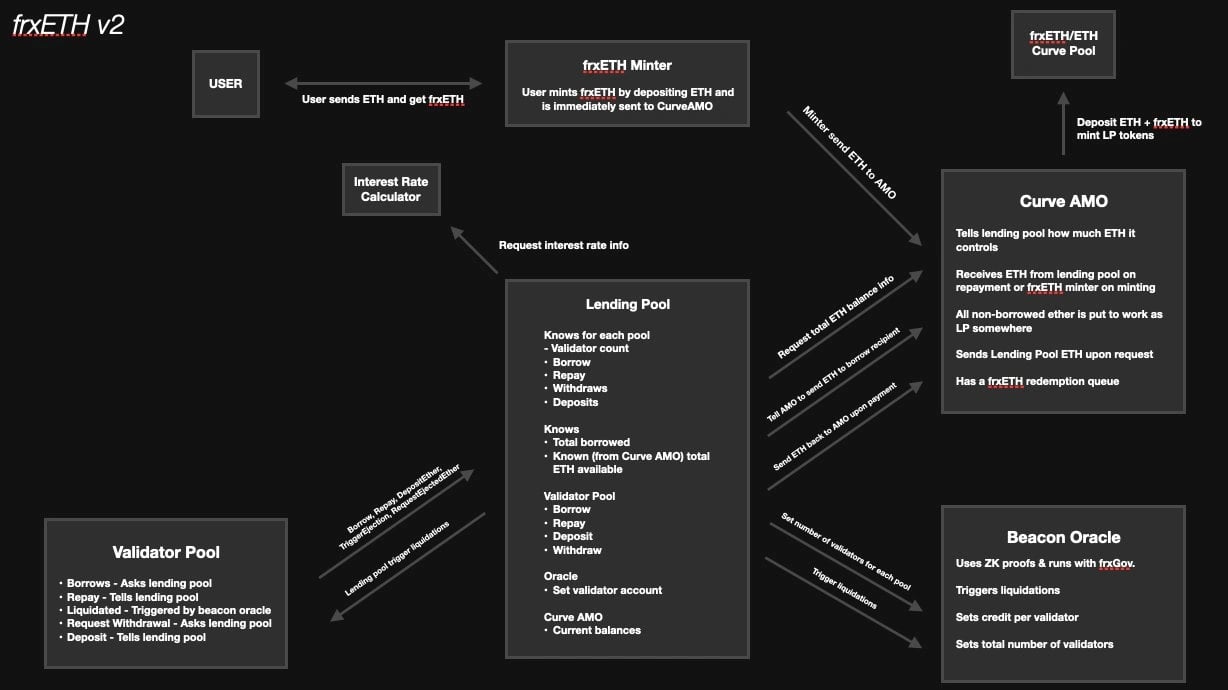위키 구독하기
Share wiki
Bookmark
Frax Ether (frxETH)
Frax Ether (frxETH)
**프랙스 이더(frxETH)**는 유동적 ETH 스테이킹 파생상품이자 스테이블코인 시스템으로, 이더리움 스테이킹 프로세스를 간소화하고 안전하게 하려는 것을 목표로 합니다. 프랙스 파이낸스 생태계를 활용하여 사용자가 보유한 ETH에 대한 이자를 획득하고 스테이킹 수익률을 극대화할 수 있는 DeFi 기반 방식을 제공합니다. [1][2]
개요
프랙스 이더 시스템은 프랙스 이더(frxETH), 스테이킹된 프랙스 이더(sfrxETH), 프랙스 ETH 민터의 세 가지 주요 구성 요소로 이루어져 있습니다.
프랙스 이더(frxETH)

frxETH는 ETH에 느슨하게 고정된 스테이블코인 역할을 하므로, 1 frxETH는 항상 1 ETH를 나타내며 유통되는 frxETH의 양은 프랙스 ETH 시스템의 ETH 양과 일치합니다. ETH가 frxETHMinter로 전송되면 동일한 양의 frxETH가 민팅됩니다. frxETH 자체를 보유하는 것은 스테이킹 수익률을 얻을 수 없으며 ETH 보유와 유사하다고 생각해야 합니다. [3] [2]
스테이킹된 프랙스 이더(sfrxETH)

sfrxETH는 ERC-4626 호환 볼트로, 프랙스 ETH 검증자가 생성하는 스테이킹 보상을 캡처합니다. 사용자는 볼트에 frxETH를 예치하여 볼트의 총 frxETH 보유량에 대한 비례 지분을 나타내는 sfrxETH를 받을 수 있습니다. 스테이킹 보상이 누적됨에 따라 새로운 frxETH가 민팅되어 볼트에 추가됩니다. 이로 인해 sfrxETH와 frxETH 간의 환율이 시간이 지남에 따라 증가하여 사용자가 초기 예치보다 많은 frxETH로 sfrxETH를 상환할 수 있습니다. 이 디자인은 aUSDC 또는 cUSDC와 같은 다른 자동 복리 수익률 토큰을 반영하여 총 sfrxETH 공급량에 대한 지분에 따라 보유자에게 스테이킹 보상을 분배합니다. [7]
프랙스 ETH 민터(frxETHMinter)
프랙스 ETH 민터는 ETH를 frxETH로 교환할 수 있게 합니다. 이는 프랙스 생태계에 ETH를 도입하고 전송된 ETH 양과 같은 새로운 frxETH를 민팅합니다. 또한 필요에 따라 새로운 검증자 노드를 설정합니다. [2] [8]
FrxETH v2
2023년 6월에 설립자 Sam Kazemian에 의해 출시된 frxETH v2 프로토콜을 통해 사용자는 ETH를 대출하고 차용할 수 있습니다. Kazemian에 따르면, FraxETH v2는 다른 프로토콜보다 더 효율적이고 분산화되도록 설계되었습니다. [4]
X 스레드에서 Kazemian은 FraxETH v2가 피어 투 풀 대출 시장을 만드는 방식으로 작동한다고 설명했습니다. ETH를 대출하려는 사용자는 FraxETH v2 풀에 예치하여 대출할 수 있으며, ETH를 차용하려는 사용자는 ETH 담보를 통해 대출을 받을 수 있습니다. [4]
ETH 차용에 대한 이자율은 시장 수요와 이용률에 따라 결정됩니다. 하드코딩된 수수료나 수수료는 없습니다. 이는 경쟁력 있는 이자율과 ETH에 대한 높은 수요를 의미합니다. [6]
“대출 시장처럼 생각하면 [[frxETH v2는] 기본적으로 가장 효율적인 LSD(Lending-Staking-Decentralized) 프로토콜입니다. 검증자 운영에 능숙한 모든 사람이 가장 낮은 금리로 우리 ETH를 빌리려고 할 것입니다.” - Sam Kazemian 인터뷰에서 언급[6]
반면, frxETH v1에서는 사용자가 ETH를 예치하고 frxETH 토큰을 받을 수 있습니다. 이 frxETH 토큰은 스테이킹 보상으로 sfrxETH 토큰을 얻기 위해 스테이킹될 수 있습니다. 또는 사용자는 Curve Finance에서 ETH-frxETH와 frxETH 토큰을 페어링하여 CRV 채굴에 참여할 수도 있습니다.
frxETH v2에서는 사용자가 LTV(담보대비대출비율)에 따라 검증자를 차용할 수 있습니다. 검증자를 “차용”하려면 사용자는 8 ETH를 초과할 수 있는 특정 양의 ETH를 담보로 제공해야 합니다. 이 담보는 사용자에게 프랙스 파이낸스에서 검증자를 차용하고 운영할 권한을 부여합니다. 동시에 대출 이자는 사용자의 ETH와 검증자 보상에서 직접 공제됩니다.

잘못된 내용이 있나요?
